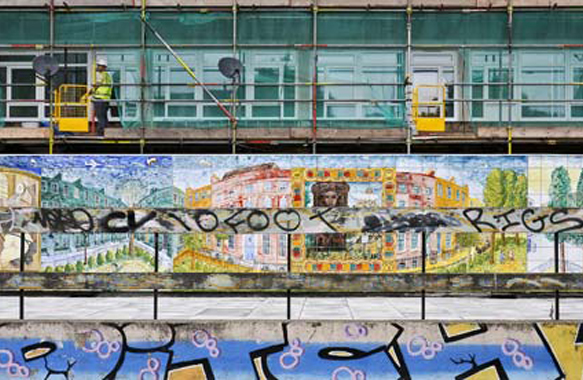Gentrification is the predominant form of neighborhood development in many cities. | Photograph: Bill Cooper
By David Madden | Originally Published at Guardian. Thursday 10 October 2013 07.30 EDT
It’s no secret that today’s big cities are massively unequal, and gentrification is now the predominant form of neighborhood development. In countless urban districts across the world, affordable housing is on the decline and displacement is on the rise. This is especially true in New York and London, where observers are straining to find sufficient prefixes (mega, hyper and super have all been aptly applied) to describe the pace at which gentrification is changing the city.
But most of the discussion about gentrification doesn’t do justice to everything at stake.
Here’s how gentrification talk typically goes: poor neighborhoods are said to need “regeneration” or “revitalization”, as if lifelessness and torpor – as opposed to impoverishment and disempowerment – were the problem. Exclusion is rebranded as creative “renewal”. The liberal mission to “increase diversity” is perversely used as an excuse to turn residents out of their homes in places like Harlem or Brixton – areas famous for their long histories of independent political and cultural scenes.
After gentrification takes hold, neighborhoods are commended for having “bounced back” from poverty, ignoring the fact that poverty has usually only been bounced elsewhere.
In an insidious way, the narrative of “urban renaissance” – the tale of heroic elites redeeming a city that had been lost to the dangerous classes – permeates a lot of contemporary thinking about cities, despite being a condescending and often racist fantasy.
When gentrification is criticized these days, it tends to be done in terms that muddle the issues. The least useful way to criticize gentrification is to obsess about an area’s character, coolness, or even worse, “grit”. Lamenting the proliferation of cupcakes and cappuccino is a staple of reporting on places like Williamsburg or Dalston.
But this kind of story reduces something that’s all about inequality to middle-class agonizing over authenticity.
It’s beyond time that policymakers, planners and urbanites de-gentrified their thinking about cities.
This will require abandoning a number of pervasive myths which have helped to legitimize inequality and contribute to gentrification’s colonization of the urbanist imagination.
The leading myth is that the only possibilities for neighborhoods are gentrification or urban decay. Well-meaning liberals sometimes think cities face a choice between the bad days of the past and a gentrified future. Urban theorists invoke this same theme with the idea of the city as a ceaselessly changing organism that can either gentrify or stagnate. But these are all deeply misleading arguments, because they offer a false choice. No serious critic of gentrification wants to maintain the status quo. Instead of either gentrification or decay, cities could push for more equal distribution of resources and more democratic decision-making.
Another myth is that gentrification actually trickles down to help everyone. Evangelists for elite-dominated urbanism sometimes argue, as New York’s mayor Michael Bloomberg did recently, that attracting the super-rich is the best way to help those city-dwellers he quaintly calls “those who are less fortunate”. But the trickle-down argument for gentrification ignores the fact that the “very fortunate” invariably seek to bend municipal priorities and local land uses towards their own needs, usually to the detriment of their less powerful neighbors. And the more that urban governments become obsessed with gutting welfare policies and punishing the poor, the less the trickle-down theory of gentrification makes sense.
Probably the most damaging myth about gentrification is that nothing can be done about it beyond wrangling a few tokenistic concessions from big developers. But gentrification is not an unstoppable force. It’s true that it has its roots in political-economic processes – the commodification of housing, the neoliberal transformation of the state and the growth of economic inequality – that require action at large scales. But there are many policies which, even in the short term, would produce a more democratic and egalitarian city: more and better public housing, rent control and regulation, community control of neighborhood space, expanding social welfare, strengthening progressive labor unions, and empowering social movements that embody the political ambitions of the urban working classes and poor.
There was a time when London, New York and other modern cities embarked on large-scale programs to build housing, educational facilities, transportation infrastructure, public health systems and public spaces to benefit all. Twentieth-century urban social democracy had its own contradictions and limitations, but it shows that even in the heartlands of capitalism, other urban landscapes are possible.
Even today, it’s not too late to unforeclose urban politics and build an alternative to the city of gentrification and inequality.
The opposite of gentrification isn’t urban decay; it’s the democratization of urban space.












Leave A Comment